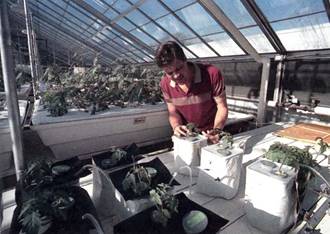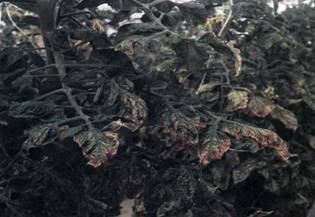


 النبات
النبات
 الحيوان
الحيوان
 الأحياء المجهرية
الأحياء المجهرية
 علم الأمراض
علم الأمراض
 التقانة الإحيائية
التقانة الإحيائية
 التقنية الحيوية المكروبية
التقنية الحيوية المكروبية
 التقنية الحياتية النانوية
التقنية الحياتية النانوية
 علم الأجنة
علم الأجنة
 الأحياء الجزيئي
الأحياء الجزيئي
 علم وظائف الأعضاء
علم وظائف الأعضاء
 الغدد
الغدد
 المضادات الحيوية
المضادات الحيوية|
Read More
Date: 1-11-2016
Date: 30-10-2015
Date: 27-10-2015
|
Essential Elements
Much research in mineral nutrition involves experiments in which a single element is supplied to a plant in excessive quantities or withheld from it. This is accomplished by growing the plant in a plant in excessive quantities or withheld from it. This is accomplished by growing the plant in a hydroponic solution whose chemical composition is carefully controlled. Hydroponic experiments were formalized and used extensively by Julius von Sachs in 1860. In such experiments, a solution is developed that supports plant growth. At first, this must be by trial and error, with numerous chemicals being added to the solution, and plants are tested to see if they survive. Many tests are necessary because some of the chemicals may be toxic, even in low concentration. Other chemicals needed by plants are toxic if present at too high a concentration. Also, the form in which a chemical is present makes a difference: Nitrogen is important, but in addition to nitrate and ammonia, which plants use, other nitrogen compounds exist which plants do not use. Also, when numerous compounds are added to the same solution, unsuspected reactions may occur that create toxic compounds or convert useful compounds to useless ones.
After a solution of known composition is found which supports plant growth, an identical solution can be prepared except that one component is left out (Fig. 1). If that component is not necessary for plant growth—that is, if it is not essential—plants grow normally. But if the excluded element is essential, the plant cannot grow correctly. For example, an experimental solution might contain nickel; if nickel is left out of the second solution, plants would grow well, perhaps even better than in the first solution; therefore, nickel is not an essential element. The second solution then becomes the main test solution. If a third solution is prepared similar to the second but lacking potassium, for example, no plant could survive; therefore potassium is an essential element and must always be included (Fig. 2). Using these hydroponic techniques, Sachs was able to establish a minimal nutrient solution that would support plant growth; it contained calcium nitrate, potassium nitrate, potassium phosphate, and magnesium sulfate. At present, several solutions are known to support reasonable growth of most plants; two are Hoagland's solution and Evan's modified Shive's solution. Many experiments begin with one of these.

FIGURE 1:In a hydroponics experiment such as this one at the University of California at Davis, the test solution is often just a water solution in a bottle of boron-free glass. Air must be bubbled through the liquid to permit root respiration (clear plastic tubes). The bottles are wrapped in foil or painted black to exclude light, more closely resemble a soil environment, and prevent the growth of algae. (L. Migdale, Science Source/Photo Researchers, Inc.)

FIGURE 2:These plants are being grown in a hydroponic solution that contains all known essential elements except one—magnesium. Even though nitrogen, sulfur, and the other elements are abundant, they are of little use to these tomato plants if one essential element is missing. Growth and reproduction are governed by the least abundant factor, not the most abundant. (John Colwell from Grant Heilman).
It may seem simpler just to grind up a plant and then extract and measure all the chemical elements present. But plants actually absorb many elements that they do not need-the endodermis simply cannot exclude them completely. A living plant usually contains at least trace quantities of every element present in the soil, whether essential to the plant or not.
The essential elements discovered by Sachs are called the major or macro essential elements because they are needed in large quantities by plants (Table ). If dry plant material is analyzed, calcium, nitrogen, potassium, phosphorus, magnesium, and sulfur are present at concentrations of between 0.1% and 3.0% of the plant's dry weight. Even as the first hydroponic experiments were being performed, botanists realized that the available chemicals were quite impure and that trace quantities of other elements were present. Despite their best efforts, they could not prepare solutions that had absolutely no copper, zinc, or many other elements. Thus, it was not possible to conclude that any particular element was completely nonessential; it was possible to determine only that relatively large amounts of most chemical elements were not essential.

As manufacturing methods improved in the chemical industry, purer compounds were produced, and mineral nutrition experiments could be repeated with more certainty that the element tested had been almost completely excluded and was present in much lower amounts than previously. With such improved chemicals, it was soon discovered that there exists a group of minor or micro essential elements, also called trace elements. Iron, boron, chlorine, copper, manganese, molybdenum, and zinc are required in extremely low concentrations by plants. Iron is the exception, being needed in amounts intermediate between those of the major and minor elements.
Although our reagents today are much purer than those of 100 years ago, it is still impossible for us to create a solution that contains absolutely only the nine major and seven minor elements. Our purest water has traces of many contaminants, the very best glass containers release silicon and boron into the solution, and all forms of chemical reagents have some trace contaminants. Chlorine was only recently discovered to be essential, at least for some plants; it remained undetected until it was realized that despite the purity of the test solutions, experimental plants receive adequate chlorine if scientists touch the plant because the skin of one fingertip has sufficient chlorine for an entire plant. Typical hydroponic experiments had shown that plants could grow in chlorine-free solutions, but when the studies were repeated with all experimenters wearing plastic gloves to prevent transfer of chlorine, the plants did not survive. Because such small quantities of chlorine are sufficient, we must suspect that other elements may also be necessary in similarly minute quantities; testing will continue whenever purer reagents become available.
CRITERIA FOR ESSENTIALITY
An element must meet three basic criteria to be considered essential.
1. The element must be necessary for complete, normal plant development through a full life cycle. If a particular element is required for any aspect of a plant's growth, differentiation, reproduction, or survival, that element is essential. This logical and necessary criterion can be difficult to test. In a hydroponic experiment, the solution and plant must be carefully protected from contamination by dust and insects, both of which are mineral-rich. The experiments must occur in laboratories, growth chambers, or specially controlled greenhouses. Laboratory conditions are not the same as the natural environment, however, and part of a plant's ability to survive depends on its response to stress: cold, heat, drought, pathogens. It may be that certain elements needed only under unusual conditions are not anticipated in a growth chamber experiment.
It is not feasible to study large trees in greenhouses or growth chambers, both because of their size and because it takes so many years to complete a life cycle. Because it is virtually impossible to test such species, the practical assumption is made that the major elements and most minor ones are essential for all plants, having been tested and found essential for many small herbs. This is a safe assumption if the role of the element is known. For example, nitrogen is present in amino acids and nucleic acids; because nothing can live without these, nitrogen is essential. The same is true for iron (cytochromes), calcium (middle lamella, enzyme control), and others. But the roles of boron and chlorine are still not known for certain, so we cannot assume with confidence that all plants require them. Furthermore, some desert plants have large amounts of silica in their epidermal cell walls; silicon is an essential element for them, but most plants appear not to need it at all.
2. The element itself must be necessary, and no substitute can be effective. This criterion is relatively straightforward; in most instances, if one essential element is absent, the presence of a chemically related element does not keep the plant alive. In some cases, elements can be substituted in specific enzymatic reactions or transport processes when studied in vitro, but even so, the whole plant cannot live with only the substitute. Some plants that require chlorine can survive if given large amounts of bromine, but such elevated levels of bromine do not occur in nature, so the substitution works only in the laboratory.
3. The element must be acting within the plant, not outside it. The complexity of test solutions makes it difficult to analyze results in many cases. Iron is an essential element, but it is soluble only in a very limited range of acidity. Although iron maybe added in adequate quantities, it often reacts with other chemical components and forms an insoluble precipitate. A test chemical can cause the precipitated iron compound to break down and form a soluble iron compound. With the new availability of iron, the plant grows well, even if the test element is not needed or absorbed. Without careful analysis, the test element would appear to be essential even though it is not used inside the plant.
This criterion has interesting ramifications. Most plants absorb phosphorus only poorly and depend on an interaction with soil fungi that absorb phosphorus and transfer it to the plant. If soil fungi are killed, plants grow poorly. If an element is essential to the fungus, is it then also essential to the plant even if the plant does not use it directly? This is one of those points that can be debated endlessly without being resolved; it is better to understand the biology than to dispute definitions.



|
|
|
|
إجراء أول اختبار لدواء "ثوري" يتصدى لعدة أنواع من السرطان
|
|
|
|
|
|
|
دراسة تكشف "سببا غريبا" يعيق نمو الطيور
|
|
|
|
|
|
قسم الشؤون الفكرية يقيم برنامج (صنّاع المحتوى الهادف) لوفدٍ من محافظة ذي قار
|
|
|
|
الهيأة العليا لإحياء التراث تنظّم ورشة عن تحقيق المخطوطات الناقصة
|
|
|
|
قسم شؤون المعارف يقيم ندوة علمية حول دور الجنوب في حركة الجهاد ضد الإنكليز
|
|
|
|
وفد جامعة الكفيل يزور دار المسنين في النجف الأشرف
|